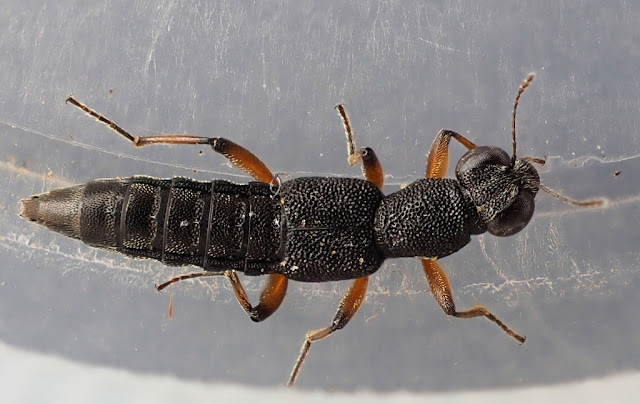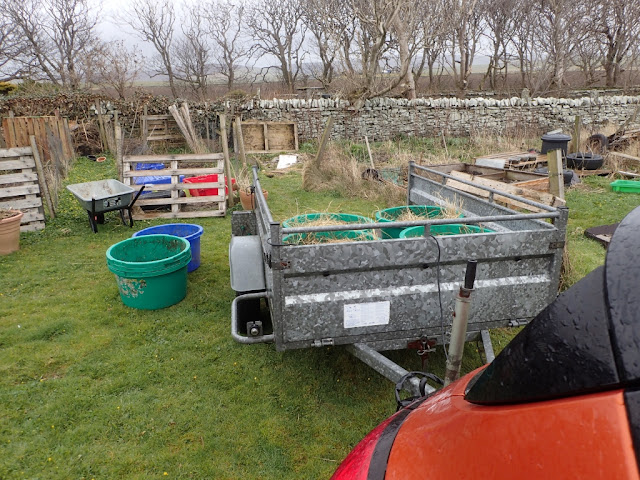A message on What'sApp mentioned a Glossy Ibis as "still present" a few minutes away, I'd not heard of it before. Anyway, Sunday morning I went to check it out.
 |
| Glossy Ibis and friends. |
I think I've seen a couple here in the past, but I'm not complaining. They are closer to the patch on each occasion, next one in the garden please.
After the ibis I walked at Skaill, along the beach, the hound rolled on the sand and went in the rock pools.
 |
| We found this which I think is a headless Porpoise skeleton. |
We then headed over to the Collembola place and armed with a pooter hoovered up a few to send off, replacing the specimens I lost last week. This mite was under a stone as was this tiny spider and its egg nest, I presume.
 |
| Trombididae I think. |
We'd gone to Brodgar on Saturday and I got distracted on the shores of Loch of Stenness. I've always thought that this saline loch ought to have some good things in the littoral areas. I managed to pull out three beetles. The Staphy disappointingly turned out to be Anotylus rugosus which I'd found elsewhere recently.
 |
| Quite pleased with this image of the head though showing the rather plain area above the mouth parts. |
The two Carabids looked a bit more exciting. The larger Pterostichus I should have known straight off that it was one of a species pair, but I'd forgotten, a while since I've seen one. I painstakingly keyed it out, not an especially easy route either, and got to the annoying P. nigrita/rhaeticus pair. Annoying because males cannot reliably be identified from physical characteristics, the genitalia are not necessarily definitive, although I have felt that ones I've seen in the past have been more nigrita than rhaeticus. However, I had a female so I did dissect it, it came out as nigrita to my eye. I ought to post it and get another opinion.
 |
| Female bits, Pterostichus nigrita. |
The third beetle was a Bembidion. I've always really liked these, although they can be a bit tricky to identify. They are very much littoral beasts and a long time ago I spent a fair bit of time in Derbyshire hunting them along riversides. Anyway, this was from saline Loch of Stenness and it wasn't too tricky as it has a very distinctive pronotum.
 |
| Bembidion aeneum. |
Pretty sure I haven't found Bembidion aeneum before, the only one with this shape of pronotum and mostly dark legs and antennae. Two, maybe three previous Orkney records.
I'm currently trying to clear the backlog of material in the fridge. This is the fridge in the garage, I'm not allowed to put things in the kitchen fridge. I've been running out of space. I've had a bit of a go at it and managed to organise the backlog. I need to have a couple of caddis days, lots of them to do. But there are a fair number of beetles too. It's some kind of hell, a cold one, shut the door, quick!
 |
| The fridge, mmm.... |
Last week I was quite excited about this beetle:
I found it moribund whilst looking at plants in Binscarth Wood. I'd thought that it was Kateretes pusillus but I'd mis-keyed a couplet. The antennae are Nitidulidae, not the closely related Kateretidae. Once that was sorted the suggestion made that it was Epuraea melanocephala (thanks MJ) could be followed up and I eventually got there (thanks MF for help along the way). This species is just as unlikely here as the Kateretes, the nearest record is south of Edinburgh and other than that there are three or four from the borders. These are tricky Families and the keys contain some awkward couplets, things hard to see at x45, like teeth at the base of the claw FFS that's hard. I'm going looking for some Amscope x20 eyepieces shortly.
There are a lot of beetles in this post. I'm really enjoying working on them, now I have the tools to do the job I can take them on with a bit more confidence. One more now. I found a Stenus type Staphy in the garden. I've not attempted one of those before. Anyway, it's alive so I thought I'd cool it, take some pix and see if it was possible to key it without taking the specimen. Fortunately, it stayed still for the portrait and it keyed out fairly straightforwardly.
 |
| Stenus clavicornis. |
And here it is on release.
 |
| Stenus clavicornis, on release. |
They're a distinctive looking genus but I know they don't all come out as easily as this one, genitalia are usually required to be dissected out. No scale on the image above as I broke my graticule today. I keep turning the wrong key on my tripod to shift the position and of course I did it today and the camera swung down and smashed the graticule. No harm to the camera and two more graticules ordered but they'll take a while to arrive.
Many mornings I start the day mucking out. The pony's an extravagance but we've had him a long time and he's very old. I don't ride but there is something about looking after a large powerful animal that's life enhancing. He's a character, I'm mostly of interest because I provide food.
 |
| Fortunately I don't have to do this job too often, poo removal. |
 |
| Blue in his field, a good spot for invertebrates. |






Your linyphiid spider under coastal rock is likely Halorates reprobus
ReplyDeleteThanks Ali, I'm heading back to the site in the next couple of days so I'll try and get some in focus pictures of the adult.
ReplyDelete